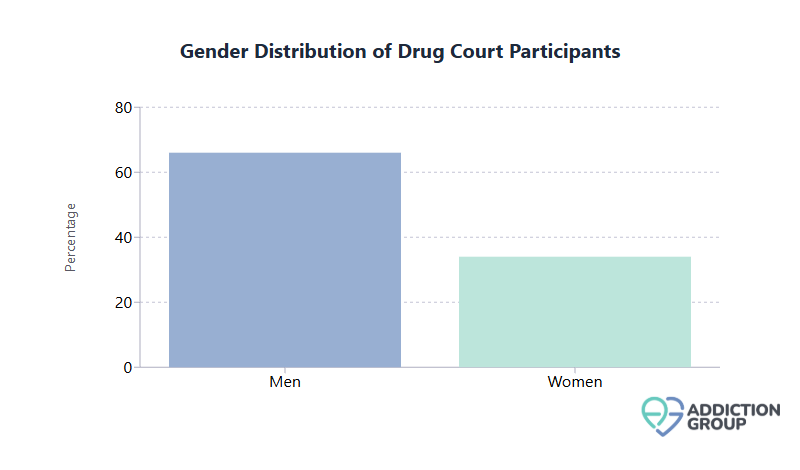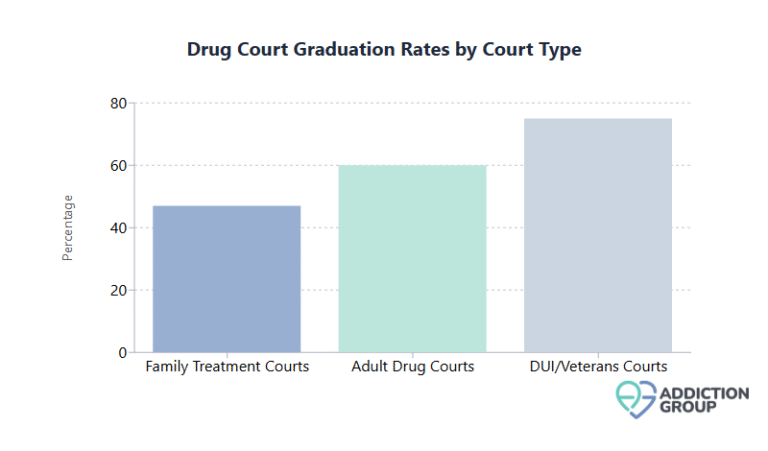“`html
Drug courts have emerged as a vital part of the justice system’s approach to dealing with substance abuse, providing an alternative to imprisonment for individuals whose criminal activities are linked to addiction.
Over the past few decades, many studies have highlighted their influence on reducing repeat offenses, achieving cost savings, and improving broader social conditions.
This article will explore the most recent statistics on drug courts in the U.S., including success rates, cost-benefit analyses, recidivism patterns, demographic insights, and more, to give a well-rounded view of how these specialized courts function and why they are expanding across the country.
Quick Snapshot: Key Drug Court Statistics
- Graduation Rates: The graduation rates for adult drug courts generally fall between 50% to 70%. Certain specialized courts, like DUI courts, can see rates exceeding 75%.
- Cost Savings: For every $1 spent on drug courts, taxpayers save between $2 to $4, and when considering broader benefits, this can reach $27 for each dollar invested.
- Recidivism Reduction: Individuals participating in drug courts have a 6 to 26 percentage point lower likelihood of being re-arrested compared to those in regular court settings, with graduates demonstrating even lower rates of re-offending over time.
- Nationwide Scope: Currently, there are over 3,800 treatment courts throughout the U.S., including adult drug courts, family treatment courts, juvenile drug courts, veterans courts, and more.
Why These Data Matter
Drug courts play a crucial role in simultaneously curbing substance abuse and crime. The statistics below illustrate how these courts enhance community safety, conserve public funds, and offer valuable rehabilitation pathways for participants who might otherwise face endless cycles of arrests and imprisonment.
Graduation and Program Completion Rates
- Overall Adult Completion: Adult drug courts typically see completion rates of 50 to 70%, exceeding those of conventional probation programs.
- Specialized Court Variations:
- DUI Courts: Often achieving graduation rates of around 75 to 80%.
- Family Treatment Courts: Averaging closer to 47%, likely due to the complex child welfare issues they address.
- Veterans Courts: With completion rates around 75%, supported by specialized services for PTSD and other combat-related challenges.
| Treatment Court Type | Typical Graduation Rate (%) |
| Adult Drug Court (ADC) | 50 to 60 |
| DUI/DWI Court | 75 to 80 |
| Family Treatment Court | ~47 |
| Veterans Treatment Court | 75 to 80 |
| Juvenile Drug Court | ~60 |
- Predictors of Success: Having a job, stable housing, and regular case management are associated with higher completion rates. Courts that allow medication-assisted treatment (MAT) for opioid dependency see improved retention rates among those participants.
Cost-Benefit Analysis
- Taxpayer Savings: Research often indicates a 200 to 400% return on investment (ROI) due to fewer incarcerations, reduced arrests, and lower legal expenses.
- Broader Economic Benefits: When considering intangible costs, such as victimization and healthcare, some analyses estimate benefits ranging from $4 to $27 per dollar spent.
- Program Variations: While most programs demonstrate net savings, the amount can vary based on local execution. Programs addressing higher-risk groups usually see the highest returns.
Recidivism Trends and Long-Term Outcomes
A prominent benefit of drug courts is the demonstrable decrease in recidivism compared to traditional legal processes.
Why This Data Is Important
High recidivism rates strain public resources and contribute to ongoing societal issues. Understanding whether drug courts significantly lower re-offense rates and the duration of that effect is essential for assessing long-term safety and cost efficiency.
- Reduced Re-Arrest Rates: Participants in drug courts are generally 6 to 26 percentage points less likely to face re-arrest, with some courts even reporting reductions of up to 50% among graduates.
- Long-Term Impact: Follow-up studies covering 3, 5, and over 10 years after graduation indicate that former participants maintain significantly lower re-offense rates. Some evaluations have noted effects lasting as long as 15 years.
Graduation vs. Non-Completion
- Graduates typically show lower rates of re-arrest compared to individuals who do not complete the program.
- Participants who do not graduate still often spend more time in treatment than they might have chosen to, which can help reduce drug use during that period.
Program Duration and Treatment Retention
Most adult drug courts operate for a minimum of 12 months, with many extending to 18 to 24 months. Research suggests that extended durations help participants establish sobriety skills and lower the chances of relapse.
Why This Data Is Important
Spending enough time in treatment is linked to lasting behavioral changes. Programs shorter than nine months may lack the intensity required for overcoming deep-rooted addictions.
- Optimal Length: Various studies indicate 9 to 12 months of continuous treatment is critical for achieving significant results.
- Phase Structures: Participants generally progress through distinct phases, initially receiving rigorous oversight and gradually gaining more independence as they advance.
Substance Type Considerations
Substance use disorders can differ greatly, ranging from alcohol to opioids to methamphetamines. Drug courts respond to these variations through specialized treatment approaches.
Why This Data Is Important
The treatment requirements for opioid dependence may not be the same as for methamphetamines or alcohol. Customizing interventions enhances the likelihood of success.
- Opioid Users: Programs that include MAT…
“““html- Medications for Opioid Dependency: Utilizing options like methadone or buprenorphine results in higher retention rates and lower relapse instances among those dependent on opioids.
- Alcohol-Focused (DUI) Courts: These courts often achieve impressive graduation rates, typically around 75% or higher.
- Stimulant Abuse (Meth/Cocaine): Lacking a medication counterpart, drug courts frequently implement strategies like contingency management and cognitive behavioral therapy. While the graduation rates may be lower, those who do succeed often experience significant reductions in substance use.
Demographics and Disparities
Drug courts aim to fairly assist offenders from diverse backgrounds, though variations in access and outcomes can be observed.
Why This Data Matters
Understanding participant demographics and success rates highlights areas where policy changes or additional resources may be necessary.
- Gender: Around two-thirds of participants are men. Graduation rates for both genders are generally close, but tailored services (like trauma-informed care) can enhance women’s success.
- Age: Younger individuals usually face more challenges in completing the program, while older participants tend to succeed more and are less likely to re-offend after graduation.
- Race/Ethnicity: White participants tend to graduate at slightly higher rates than Black participants, with a national gap of about 4 to 5 percentage points. Courts are increasingly focusing on cultural competence and fair admission processes to address this issue.
- Socioeconomic Factors: Those entering with stable housing and employment generally perform better, although drug courts often assist the unemployed and homeless in achieving stability by the time they graduate.

Geographic Variation and Accessibility
Drug courts are present in all U.S. states, although their availability and capacity can vary significantly.
Why This Data Matters
People in underserved areas might be deprived of treatment-based alternatives to jail.
- Urban vs. Rural:
- Urban courts often benefit from a wider range of treatment services, but they can be overwhelmed with high caseloads.
- Rural courts encounter challenges like limited public transport and fewer treatment facilities, though smaller participant numbers may allow for more individualized attention.
- National Reach: More than 3,800 treatment courts operate across the U.S., including over 1,600 adult drug courts, with ongoing initiatives to broaden access in remote areas.
Support Services and Comprehensive Care
Why This Data Matters
Since addiction frequently coexists with mental health issues, joblessness, and homelessness, strong support systems can be crucial for preventing relapse.
- Mental Health Services: Many participants face co-occurring disorders; programs that offer integrated therapy and psychiatric support tend to have better graduation outcomes.
- Housing Support: Providing transitional or sober living accommodations often enhances program retention and decreases relapse chances.
- Job and Skill Development: Courts collaborate with job agencies to provide training and educational opportunities. Reports indicate that 87% of drug court graduates secure employment upon completion.
- Family & Parenting Services: Vital within family treatment courts, these services have significantly increased reunification rates in some research, leading to quicker permanency decisions and lower foster care costs.
Family Reunification Rates
Why This Data Matters
- Reunification Rates: Research indicates that participants in family drug courts have twice the chance of regaining custody compared to those in traditional dependency court systems.
- Shorter Foster Care Stays: Children generally have fewer months in out-of-home placements, reducing emotional strain and financial pressure on families and child welfare organizations.
Employment and Housing Outcomes
Why This Data Matters
- Workforce Improvements: Many participants begin without a steady income or stable job history. By graduation, over 80% secure reliable employment, which is essential for self-sufficiency.
- Housing Security: Courts typically assist participants in finding transitional or permanent housing. In a multi-year evaluation, 100% of graduates had stable housing upon completion.
Long-Term Effects and Quality of Life
Why This Data Matters
- Health Improvements: Access to substance abuse treatment, mental health services, and regular check-ups leads to notable enhancements in general wellness.
- Increased Self-Worth and Community Support: Graduates often report greater confidence, better family relations, and enhanced support networks.
- Lower Public Health Risks: For those dealing with opioid addiction, medication-assisted treatment (MAT) significantly reduces risks of overdose and disease transmission, which benefits the entire community.
Eligibility Criteria and Barriers to Entry
Why This Data Matters
- Common Exclusions: Individuals with recent violent felonies, significant drug trafficking convictions, or severe untreated mental health issues may be disqualified.
- Acceptance Challenges: Some eligible individuals opt out of the program due to its demands, choosing a shorter jail sentence over the longer commitment required by drug court.
- Racial and Socioeconomic Barriers: Data indicate that minorities are often underrepresented in specific jurisdictions, prompting reforms such as bias awareness training and standardized assessment procedures.
Conclusion
This framework goes beyond traditional legal processes by promoting meaningful rehabilitation and encouraging a transformation from offender to a responsible, thriving community member.
Moreover, the wider social benefits include stable housing, employment opportunities, and healthier family environments. With tailored programs for veterans, parents involved in child welfare, and those facing mental health issues, drug courts are continually adapting to serve diverse needs.
The consistent evidence indicates that expanded access and inclusive admission policies represent the future. These policies ensure that anyone who could gain from a treatment-focused approach is afforded that chance.
Ultimately, the data present a compelling narrative of change. Drug courts do more than just lower crime statistics; they redirect lives towards more promising paths. They fortify families, facilitate recovery, and champion a more effective, rehabilitative approach to justice.
“`


